Economics and Quantitative Analysis: Linear Regression Report, 2019
VerifiedAdded on 2023/04/26
|8
|1821
|246
Report
AI Summary
This report presents a linear regression analysis examining the relationship between graduation and retention rates in online colleges. The study utilizes data from the Online Education Database, focusing on 29 colleges. The report includes descriptive statistics, a scatter plot illustrating a positive correlation between retention and graduation rates, and the estimation of a regression equation. The analysis reveals a statistically significant positive correlation, with the R-squared value indicating that approximately 44.92% of the variation in graduation rates is explained by changes in retention rates. The report also analyzes the performance of two specific universities, South University and Phoenix University, based on their graduation and retention rates. The findings lead to recommendations for improving student support, curriculum quality, and student comfort to enhance retention and graduation rates. The analysis underscores the importance of these rates in assessing the quality and competitiveness of online higher education institutions.
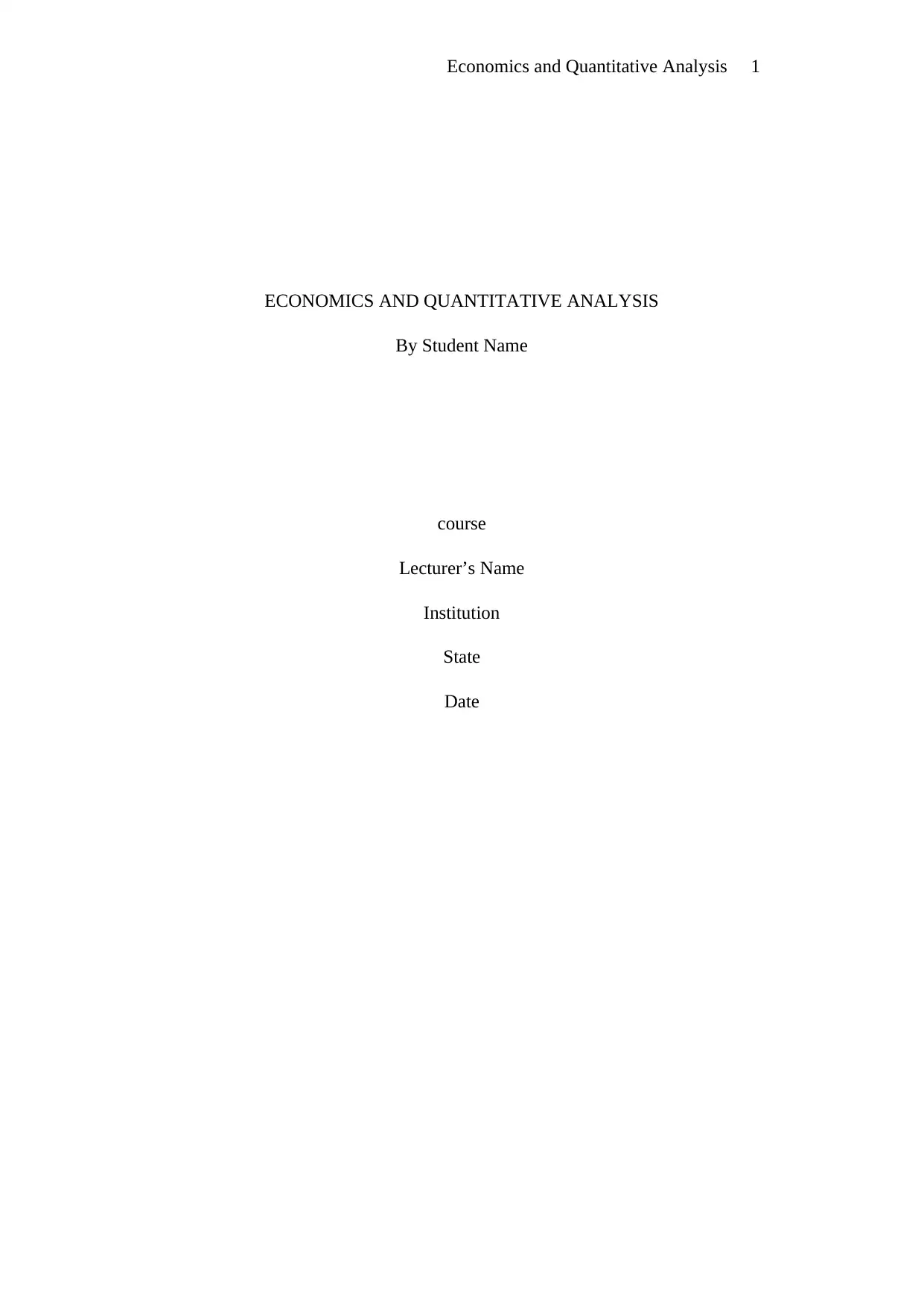
Economics and Quantitative Analysis 1
ECONOMICS AND QUANTITATIVE ANALYSIS
By Student Name
course
Lecturer’s Name
Institution
State
Date
ECONOMICS AND QUANTITATIVE ANALYSIS
By Student Name
course
Lecturer’s Name
Institution
State
Date
Paraphrase This Document
Need a fresh take? Get an instant paraphrase of this document with our AI Paraphraser
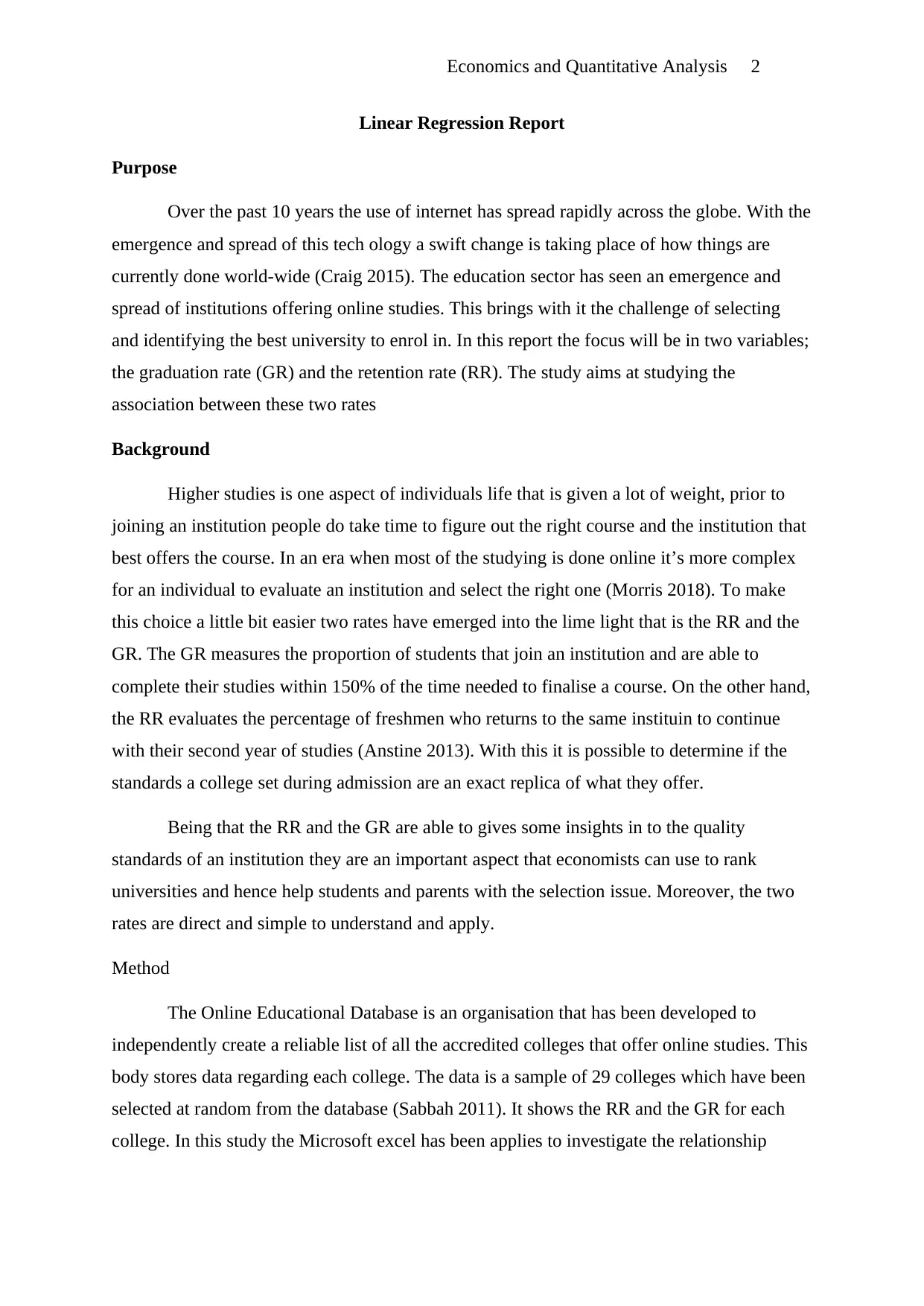
Economics and Quantitative Analysis 2
Linear Regression Report
Purpose
Over the past 10 years the use of internet has spread rapidly across the globe. With the
emergence and spread of this tech ology a swift change is taking place of how things are
currently done world-wide (Craig 2015). The education sector has seen an emergence and
spread of institutions offering online studies. This brings with it the challenge of selecting
and identifying the best university to enrol in. In this report the focus will be in two variables;
the graduation rate (GR) and the retention rate (RR). The study aims at studying the
association between these two rates
Background
Higher studies is one aspect of individuals life that is given a lot of weight, prior to
joining an institution people do take time to figure out the right course and the institution that
best offers the course. In an era when most of the studying is done online it’s more complex
for an individual to evaluate an institution and select the right one (Morris 2018). To make
this choice a little bit easier two rates have emerged into the lime light that is the RR and the
GR. The GR measures the proportion of students that join an institution and are able to
complete their studies within 150% of the time needed to finalise a course. On the other hand,
the RR evaluates the percentage of freshmen who returns to the same instituin to continue
with their second year of studies (Anstine 2013). With this it is possible to determine if the
standards a college set during admission are an exact replica of what they offer.
Being that the RR and the GR are able to gives some insights in to the quality
standards of an institution they are an important aspect that economists can use to rank
universities and hence help students and parents with the selection issue. Moreover, the two
rates are direct and simple to understand and apply.
Method
The Online Educational Database is an organisation that has been developed to
independently create a reliable list of all the accredited colleges that offer online studies. This
body stores data regarding each college. The data is a sample of 29 colleges which have been
selected at random from the database (Sabbah 2011). It shows the RR and the GR for each
college. In this study the Microsoft excel has been applies to investigate the relationship
Linear Regression Report
Purpose
Over the past 10 years the use of internet has spread rapidly across the globe. With the
emergence and spread of this tech ology a swift change is taking place of how things are
currently done world-wide (Craig 2015). The education sector has seen an emergence and
spread of institutions offering online studies. This brings with it the challenge of selecting
and identifying the best university to enrol in. In this report the focus will be in two variables;
the graduation rate (GR) and the retention rate (RR). The study aims at studying the
association between these two rates
Background
Higher studies is one aspect of individuals life that is given a lot of weight, prior to
joining an institution people do take time to figure out the right course and the institution that
best offers the course. In an era when most of the studying is done online it’s more complex
for an individual to evaluate an institution and select the right one (Morris 2018). To make
this choice a little bit easier two rates have emerged into the lime light that is the RR and the
GR. The GR measures the proportion of students that join an institution and are able to
complete their studies within 150% of the time needed to finalise a course. On the other hand,
the RR evaluates the percentage of freshmen who returns to the same instituin to continue
with their second year of studies (Anstine 2013). With this it is possible to determine if the
standards a college set during admission are an exact replica of what they offer.
Being that the RR and the GR are able to gives some insights in to the quality
standards of an institution they are an important aspect that economists can use to rank
universities and hence help students and parents with the selection issue. Moreover, the two
rates are direct and simple to understand and apply.
Method
The Online Educational Database is an organisation that has been developed to
independently create a reliable list of all the accredited colleges that offer online studies. This
body stores data regarding each college. The data is a sample of 29 colleges which have been
selected at random from the database (Sabbah 2011). It shows the RR and the GR for each
college. In this study the Microsoft excel has been applies to investigate the relationship

Economics and Quantitative Analysis 3
between the two rates. The analysis involves development of scatter plot, modelling simple
linear regression as well as drawing descriptive analysis from the data.
Results
a. Descriptive analysis
This is the numerical analysis of the data sample as presented by the table below
Descriptive Statistics
RR(%) GR(%)
Mean 57.4137931 Mean 41.75862069
Standard Error 4.315602704 Standard Error 1.832018976
Median 60 Median 39
Mode 51 Mode 36
Standard Deviation 23.24023181 Standard Deviation 9.865724115
Sample Variance 540.1083744 Sample Variance 97.33251232
Kurtosis 0.461757455 Kurtosis -0.882399313
Skewness -0.309920645 Skewness 0.176364432
Range 96 Range 36
Minimum 4 Minimum 25
Maximum 100 Maximum 61
Sum 1665 Sum 1211
Count 29 Count 29
Largest(1) 100 Largest(1) 61
Smallest(1) 4 Smallest(1) 25
b. Scatter plot
This is the visual presentation of the two variables the RR is the independent
variable (x) while the GR is the dependent variable (y). The diagram below
represents the scatter plot (Vice Further Maths Tutorials 2011).
between the two rates. The analysis involves development of scatter plot, modelling simple
linear regression as well as drawing descriptive analysis from the data.
Results
a. Descriptive analysis
This is the numerical analysis of the data sample as presented by the table below
Descriptive Statistics
RR(%) GR(%)
Mean 57.4137931 Mean 41.75862069
Standard Error 4.315602704 Standard Error 1.832018976
Median 60 Median 39
Mode 51 Mode 36
Standard Deviation 23.24023181 Standard Deviation 9.865724115
Sample Variance 540.1083744 Sample Variance 97.33251232
Kurtosis 0.461757455 Kurtosis -0.882399313
Skewness -0.309920645 Skewness 0.176364432
Range 96 Range 36
Minimum 4 Minimum 25
Maximum 100 Maximum 61
Sum 1665 Sum 1211
Count 29 Count 29
Largest(1) 100 Largest(1) 61
Smallest(1) 4 Smallest(1) 25
b. Scatter plot
This is the visual presentation of the two variables the RR is the independent
variable (x) while the GR is the dependent variable (y). The diagram below
represents the scatter plot (Vice Further Maths Tutorials 2011).
⊘ This is a preview!⊘
Do you want full access?
Subscribe today to unlock all pages.

Trusted by 1+ million students worldwide
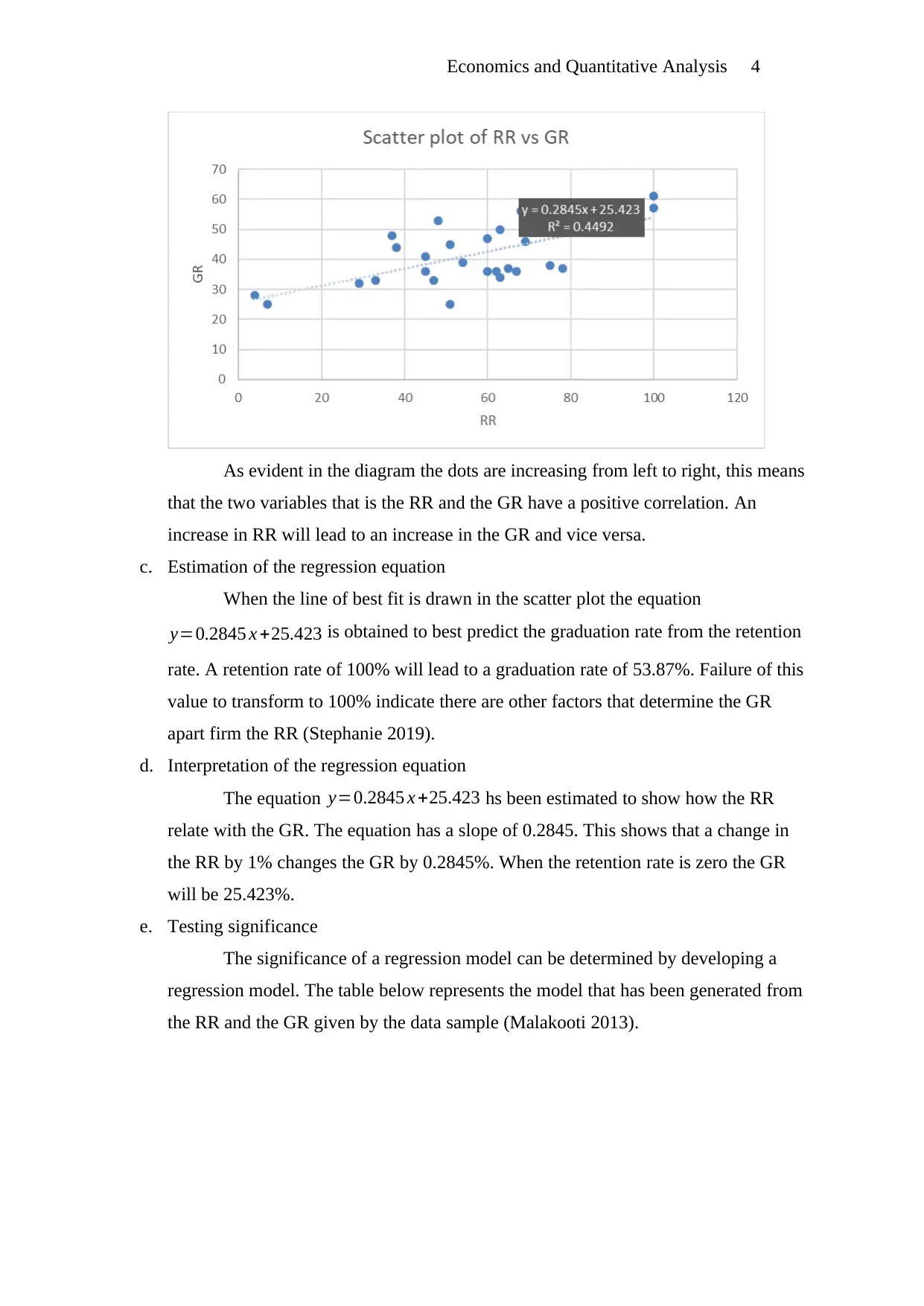
Economics and Quantitative Analysis 4
As evident in the diagram the dots are increasing from left to right, this means
that the two variables that is the RR and the GR have a positive correlation. An
increase in RR will lead to an increase in the GR and vice versa.
c. Estimation of the regression equation
When the line of best fit is drawn in the scatter plot the equation
y=0.2845 x +25.423 is obtained to best predict the graduation rate from the retention
rate. A retention rate of 100% will lead to a graduation rate of 53.87%. Failure of this
value to transform to 100% indicate there are other factors that determine the GR
apart firm the RR (Stephanie 2019).
d. Interpretation of the regression equation
The equation y=0.2845 x +25.423 hs been estimated to show how the RR
relate with the GR. The equation has a slope of 0.2845. This shows that a change in
the RR by 1% changes the GR by 0.2845%. When the retention rate is zero the GR
will be 25.423%.
e. Testing significance
The significance of a regression model can be determined by developing a
regression model. The table below represents the model that has been generated from
the RR and the GR given by the data sample (Malakooti 2013).
As evident in the diagram the dots are increasing from left to right, this means
that the two variables that is the RR and the GR have a positive correlation. An
increase in RR will lead to an increase in the GR and vice versa.
c. Estimation of the regression equation
When the line of best fit is drawn in the scatter plot the equation
y=0.2845 x +25.423 is obtained to best predict the graduation rate from the retention
rate. A retention rate of 100% will lead to a graduation rate of 53.87%. Failure of this
value to transform to 100% indicate there are other factors that determine the GR
apart firm the RR (Stephanie 2019).
d. Interpretation of the regression equation
The equation y=0.2845 x +25.423 hs been estimated to show how the RR
relate with the GR. The equation has a slope of 0.2845. This shows that a change in
the RR by 1% changes the GR by 0.2845%. When the retention rate is zero the GR
will be 25.423%.
e. Testing significance
The significance of a regression model can be determined by developing a
regression model. The table below represents the model that has been generated from
the RR and the GR given by the data sample (Malakooti 2013).
Paraphrase This Document
Need a fresh take? Get an instant paraphrase of this document with our AI Paraphraser
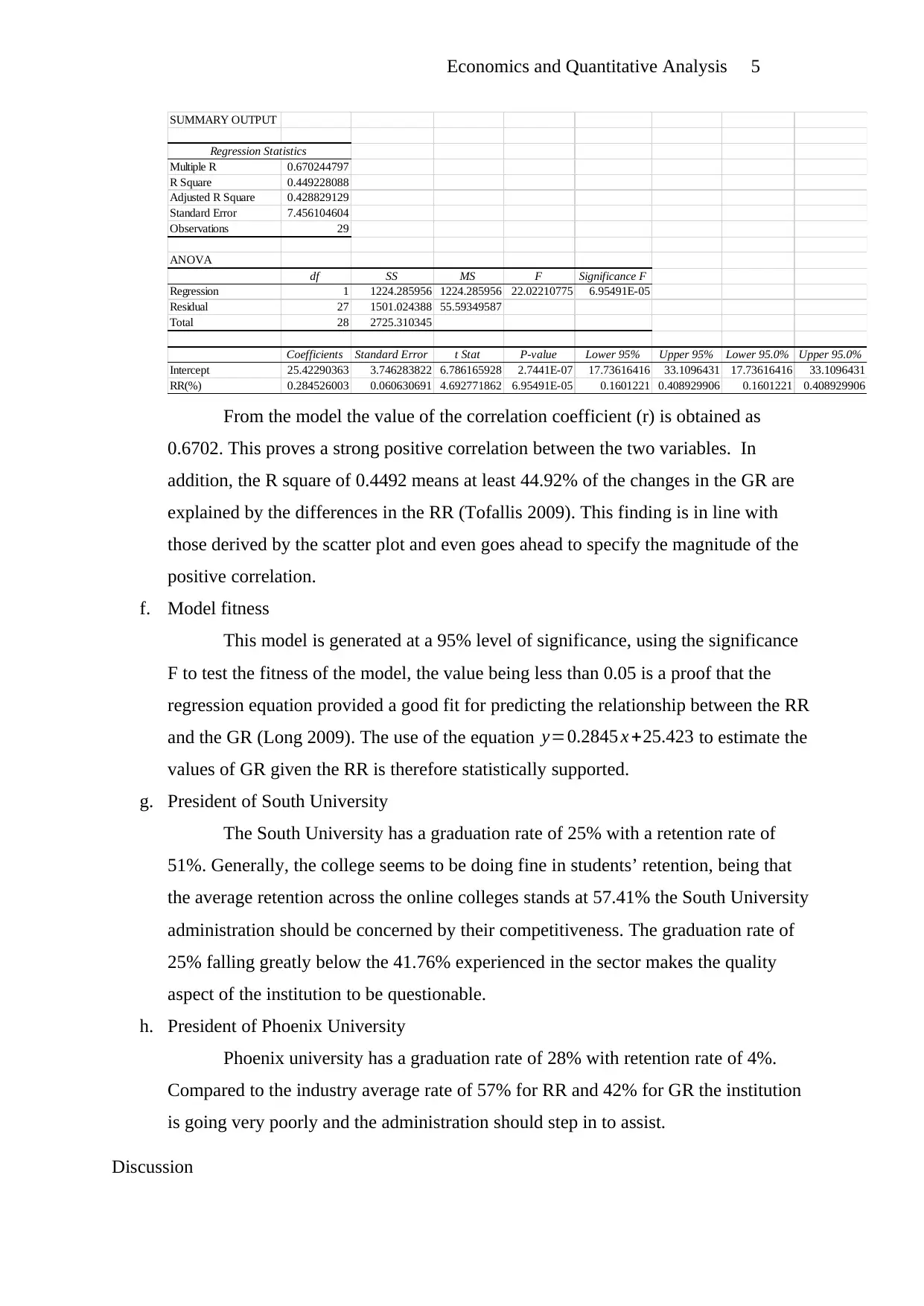
Economics and Quantitative Analysis 5
SUMMARY OUTPUT
Regression Statistics
Multiple R 0.670244797
R Square 0.449228088
Adjusted R Square 0.428829129
Standard Error 7.456104604
Observations 29
ANOVA
df SS MS F Significance F
Regression 1 1224.285956 1224.285956 22.02210775 6.95491E-05
Residual 27 1501.024388 55.59349587
Total 28 2725.310345
Coefficients Standard Error t Stat P-value Lower 95% Upper 95% Lower 95.0% Upper 95.0%
Intercept 25.42290363 3.746283822 6.786165928 2.7441E-07 17.73616416 33.1096431 17.73616416 33.1096431
RR(%) 0.284526003 0.060630691 4.692771862 6.95491E-05 0.1601221 0.408929906 0.1601221 0.408929906
From the model the value of the correlation coefficient (r) is obtained as
0.6702. This proves a strong positive correlation between the two variables. In
addition, the R square of 0.4492 means at least 44.92% of the changes in the GR are
explained by the differences in the RR (Tofallis 2009). This finding is in line with
those derived by the scatter plot and even goes ahead to specify the magnitude of the
positive correlation.
f. Model fitness
This model is generated at a 95% level of significance, using the significance
F to test the fitness of the model, the value being less than 0.05 is a proof that the
regression equation provided a good fit for predicting the relationship between the RR
and the GR (Long 2009). The use of the equation y=0.2845 x +25.423 to estimate the
values of GR given the RR is therefore statistically supported.
g. President of South University
The South University has a graduation rate of 25% with a retention rate of
51%. Generally, the college seems to be doing fine in students’ retention, being that
the average retention across the online colleges stands at 57.41% the South University
administration should be concerned by their competitiveness. The graduation rate of
25% falling greatly below the 41.76% experienced in the sector makes the quality
aspect of the institution to be questionable.
h. President of Phoenix University
Phoenix university has a graduation rate of 28% with retention rate of 4%.
Compared to the industry average rate of 57% for RR and 42% for GR the institution
is going very poorly and the administration should step in to assist.
Discussion
SUMMARY OUTPUT
Regression Statistics
Multiple R 0.670244797
R Square 0.449228088
Adjusted R Square 0.428829129
Standard Error 7.456104604
Observations 29
ANOVA
df SS MS F Significance F
Regression 1 1224.285956 1224.285956 22.02210775 6.95491E-05
Residual 27 1501.024388 55.59349587
Total 28 2725.310345
Coefficients Standard Error t Stat P-value Lower 95% Upper 95% Lower 95.0% Upper 95.0%
Intercept 25.42290363 3.746283822 6.786165928 2.7441E-07 17.73616416 33.1096431 17.73616416 33.1096431
RR(%) 0.284526003 0.060630691 4.692771862 6.95491E-05 0.1601221 0.408929906 0.1601221 0.408929906
From the model the value of the correlation coefficient (r) is obtained as
0.6702. This proves a strong positive correlation between the two variables. In
addition, the R square of 0.4492 means at least 44.92% of the changes in the GR are
explained by the differences in the RR (Tofallis 2009). This finding is in line with
those derived by the scatter plot and even goes ahead to specify the magnitude of the
positive correlation.
f. Model fitness
This model is generated at a 95% level of significance, using the significance
F to test the fitness of the model, the value being less than 0.05 is a proof that the
regression equation provided a good fit for predicting the relationship between the RR
and the GR (Long 2009). The use of the equation y=0.2845 x +25.423 to estimate the
values of GR given the RR is therefore statistically supported.
g. President of South University
The South University has a graduation rate of 25% with a retention rate of
51%. Generally, the college seems to be doing fine in students’ retention, being that
the average retention across the online colleges stands at 57.41% the South University
administration should be concerned by their competitiveness. The graduation rate of
25% falling greatly below the 41.76% experienced in the sector makes the quality
aspect of the institution to be questionable.
h. President of Phoenix University
Phoenix university has a graduation rate of 28% with retention rate of 4%.
Compared to the industry average rate of 57% for RR and 42% for GR the institution
is going very poorly and the administration should step in to assist.
Discussion

Economics and Quantitative Analysis 6
The descriptive analysis of the sample data gives the lowest RR to be 4% while the
highest is 100%. The man of the retention rate is 57.41%. On the other hand, the college with
the; lowest graduation rate has 25% with the rate having a range of 36%. The GR have a
mean of 41.76%. As visible from the scatter plot the RR has a positive correlation with the
GR. Estimation of the regression equation farther support this due to the present of a positive
gradient. A correlation coefficient of 0.6702 is a proof of strong positive association between
RR and GR.
The use of secondary data that has been verified makes the results of the analysis
more reliable. The major problem with the findings is that nit all the factors determining
quality of education in an institution have been taken into account hence the recommendation
given might be misleading.
Recommendations
From the results of the analysis the following three recommendations need to be taken
in to account by the presidents of South University and Phoenix University
1. Undertake raining of staff to improve handling of students
2. Evaluate their curriculum to ensure students get quality education.
3. Undertake a study of students comfort in the institution so as to establish the root
of the low retention rate.
The descriptive analysis of the sample data gives the lowest RR to be 4% while the
highest is 100%. The man of the retention rate is 57.41%. On the other hand, the college with
the; lowest graduation rate has 25% with the rate having a range of 36%. The GR have a
mean of 41.76%. As visible from the scatter plot the RR has a positive correlation with the
GR. Estimation of the regression equation farther support this due to the present of a positive
gradient. A correlation coefficient of 0.6702 is a proof of strong positive association between
RR and GR.
The use of secondary data that has been verified makes the results of the analysis
more reliable. The major problem with the findings is that nit all the factors determining
quality of education in an institution have been taken into account hence the recommendation
given might be misleading.
Recommendations
From the results of the analysis the following three recommendations need to be taken
in to account by the presidents of South University and Phoenix University
1. Undertake raining of staff to improve handling of students
2. Evaluate their curriculum to ensure students get quality education.
3. Undertake a study of students comfort in the institution so as to establish the root
of the low retention rate.
⊘ This is a preview!⊘
Do you want full access?
Subscribe today to unlock all pages.

Trusted by 1+ million students worldwide
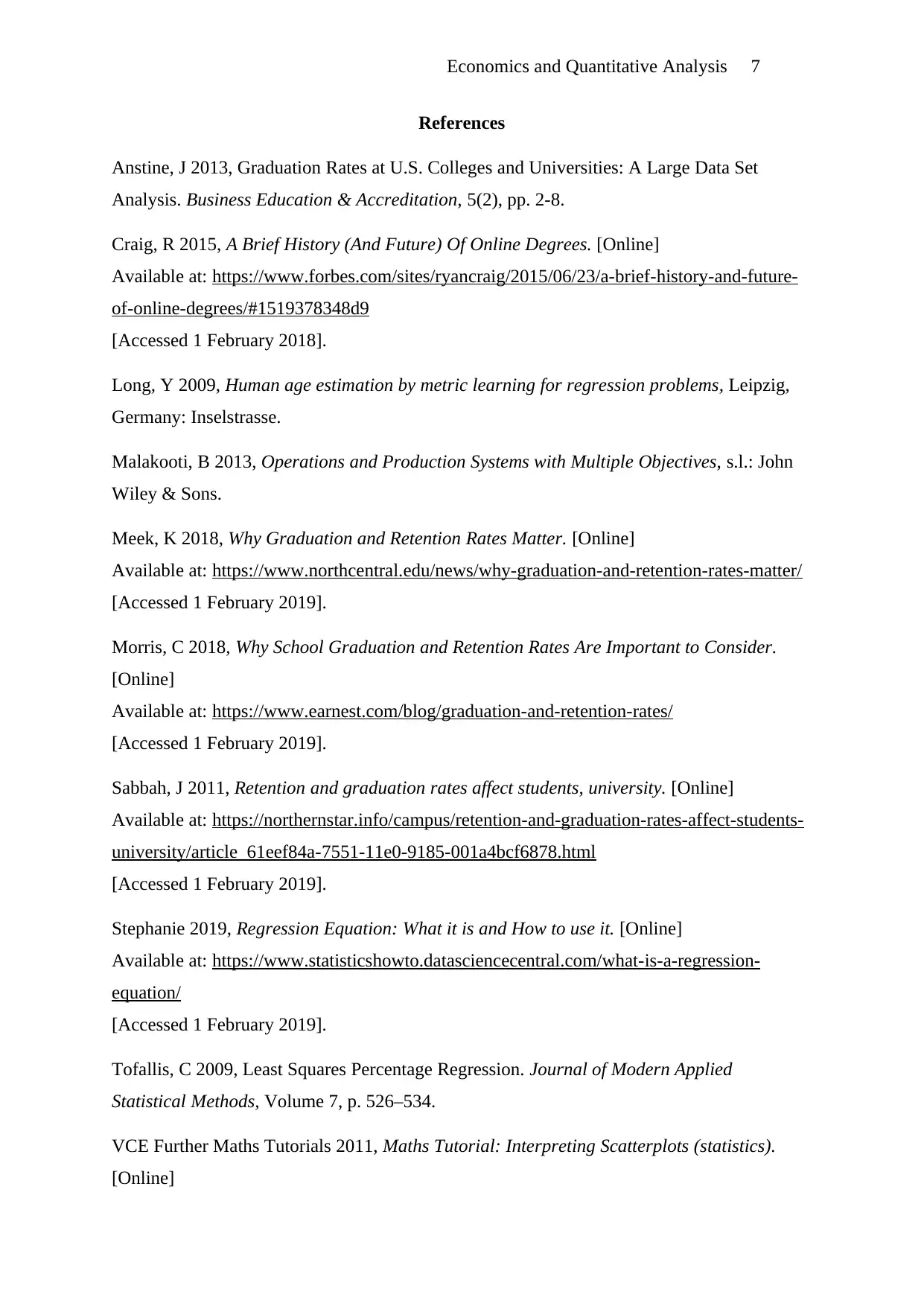
Economics and Quantitative Analysis 7
References
Anstine, J 2013, Graduation Rates at U.S. Colleges and Universities: A Large Data Set
Analysis. Business Education & Accreditation, 5(2), pp. 2-8.
Craig, R 2015, A Brief History (And Future) Of Online Degrees. [Online]
Available at: https://www.forbes.com/sites/ryancraig/2015/06/23/a-brief-history-and-future-
of-online-degrees/#1519378348d9
[Accessed 1 February 2018].
Long, Y 2009, Human age estimation by metric learning for regression problems, Leipzig,
Germany: Inselstrasse.
Malakooti, B 2013, Operations and Production Systems with Multiple Objectives, s.l.: John
Wiley & Sons.
Meek, K 2018, Why Graduation and Retention Rates Matter. [Online]
Available at: https://www.northcentral.edu/news/why-graduation-and-retention-rates-matter/
[Accessed 1 February 2019].
Morris, C 2018, Why School Graduation and Retention Rates Are Important to Consider.
[Online]
Available at: https://www.earnest.com/blog/graduation-and-retention-rates/
[Accessed 1 February 2019].
Sabbah, J 2011, Retention and graduation rates affect students, university. [Online]
Available at: https://northernstar.info/campus/retention-and-graduation-rates-affect-students-
university/article_61eef84a-7551-11e0-9185-001a4bcf6878.html
[Accessed 1 February 2019].
Stephanie 2019, Regression Equation: What it is and How to use it. [Online]
Available at: https://www.statisticshowto.datasciencecentral.com/what-is-a-regression-
equation/
[Accessed 1 February 2019].
Tofallis, C 2009, Least Squares Percentage Regression. Journal of Modern Applied
Statistical Methods, Volume 7, p. 526–534.
VCE Further Maths Tutorials 2011, Maths Tutorial: Interpreting Scatterplots (statistics).
[Online]
References
Anstine, J 2013, Graduation Rates at U.S. Colleges and Universities: A Large Data Set
Analysis. Business Education & Accreditation, 5(2), pp. 2-8.
Craig, R 2015, A Brief History (And Future) Of Online Degrees. [Online]
Available at: https://www.forbes.com/sites/ryancraig/2015/06/23/a-brief-history-and-future-
of-online-degrees/#1519378348d9
[Accessed 1 February 2018].
Long, Y 2009, Human age estimation by metric learning for regression problems, Leipzig,
Germany: Inselstrasse.
Malakooti, B 2013, Operations and Production Systems with Multiple Objectives, s.l.: John
Wiley & Sons.
Meek, K 2018, Why Graduation and Retention Rates Matter. [Online]
Available at: https://www.northcentral.edu/news/why-graduation-and-retention-rates-matter/
[Accessed 1 February 2019].
Morris, C 2018, Why School Graduation and Retention Rates Are Important to Consider.
[Online]
Available at: https://www.earnest.com/blog/graduation-and-retention-rates/
[Accessed 1 February 2019].
Sabbah, J 2011, Retention and graduation rates affect students, university. [Online]
Available at: https://northernstar.info/campus/retention-and-graduation-rates-affect-students-
university/article_61eef84a-7551-11e0-9185-001a4bcf6878.html
[Accessed 1 February 2019].
Stephanie 2019, Regression Equation: What it is and How to use it. [Online]
Available at: https://www.statisticshowto.datasciencecentral.com/what-is-a-regression-
equation/
[Accessed 1 February 2019].
Tofallis, C 2009, Least Squares Percentage Regression. Journal of Modern Applied
Statistical Methods, Volume 7, p. 526–534.
VCE Further Maths Tutorials 2011, Maths Tutorial: Interpreting Scatterplots (statistics).
[Online]
Paraphrase This Document
Need a fresh take? Get an instant paraphrase of this document with our AI Paraphraser
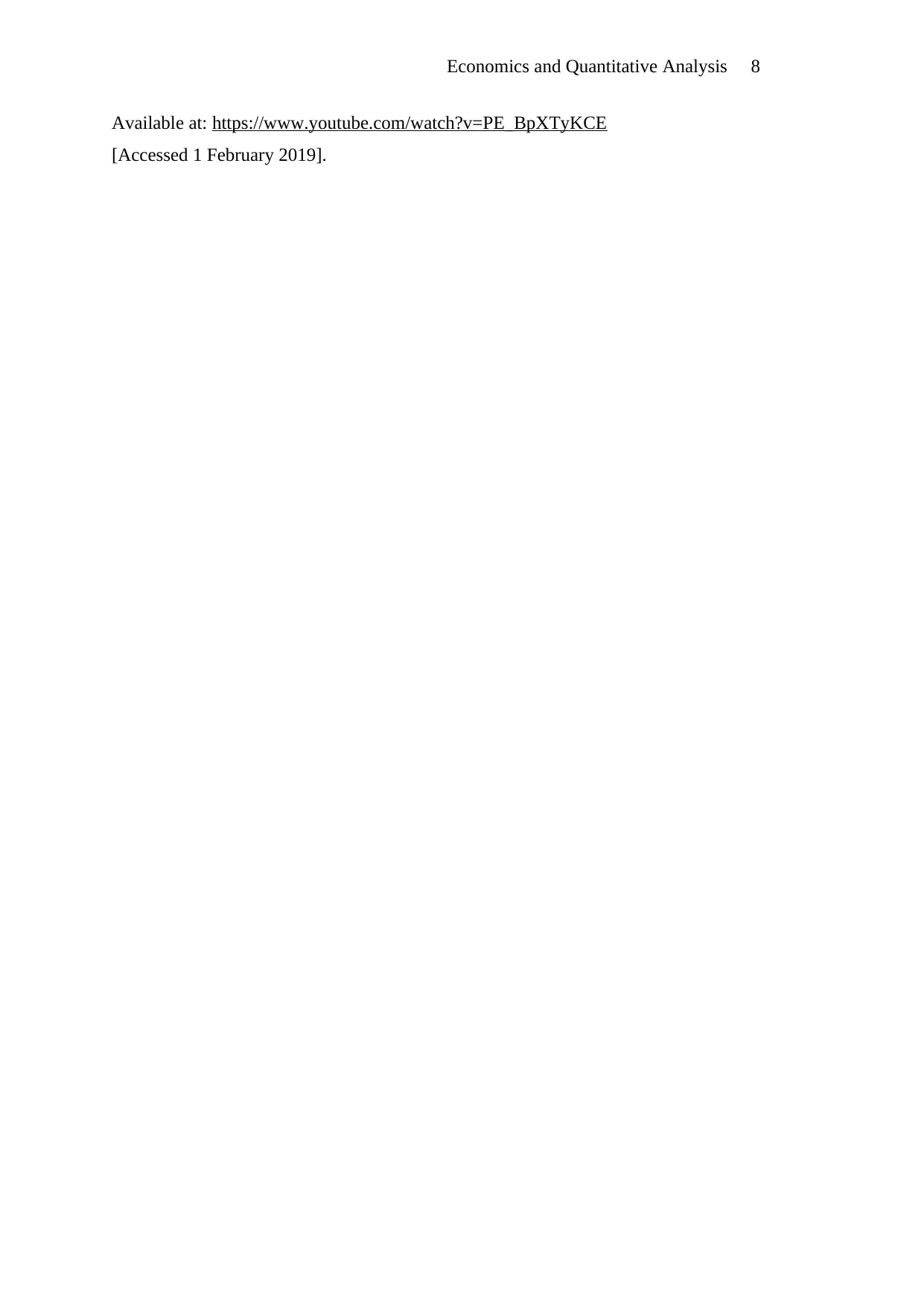
Economics and Quantitative Analysis 8
Available at: https://www.youtube.com/watch?v=PE_BpXTyKCE
[Accessed 1 February 2019].
Available at: https://www.youtube.com/watch?v=PE_BpXTyKCE
[Accessed 1 February 2019].
1 out of 8
Related Documents
Your All-in-One AI-Powered Toolkit for Academic Success.
+13062052269
info@desklib.com
Available 24*7 on WhatsApp / Email
![[object Object]](/_next/static/media/star-bottom.7253800d.svg)
Unlock your academic potential
Copyright © 2020–2025 A2Z Services. All Rights Reserved. Developed and managed by ZUCOL.





